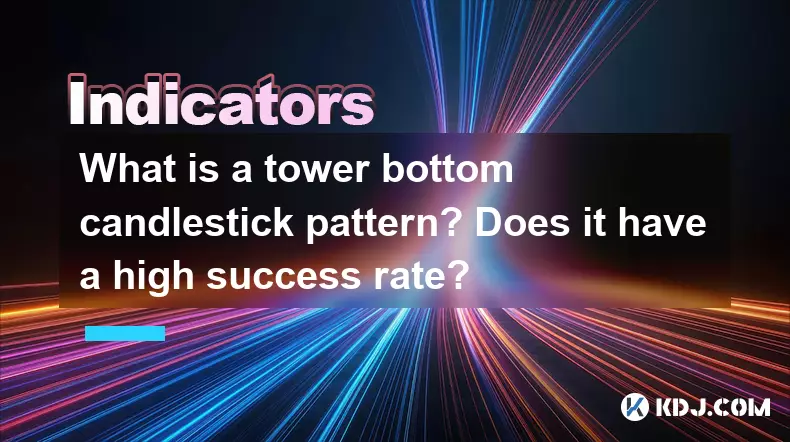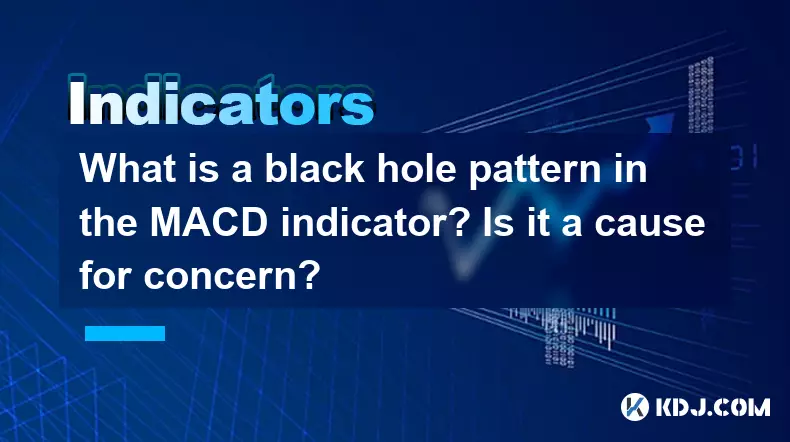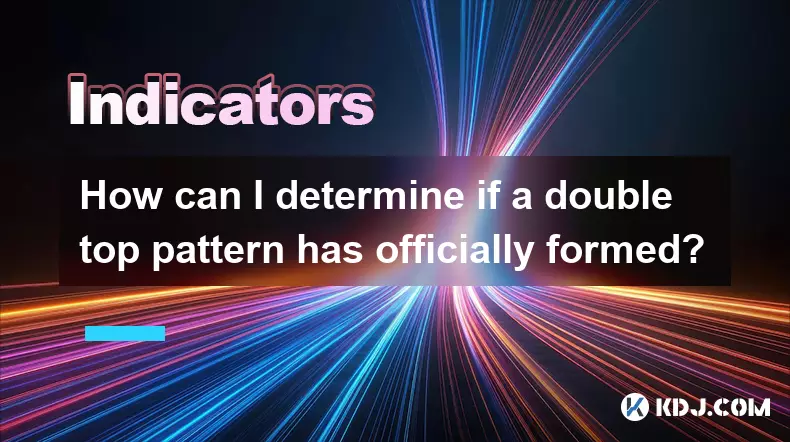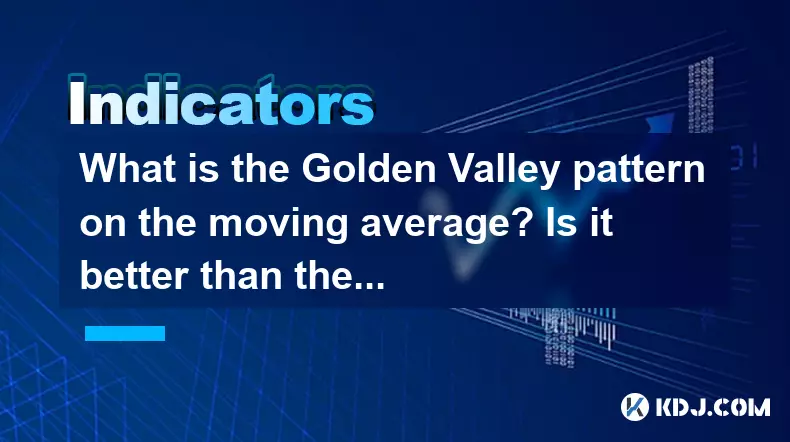-
 bitcoin
bitcoin $109523.663807 USD
-0.13% -
 ethereum
ethereum $4019.526508 USD
2.06% -
 tether
tether $1.000482 USD
0.00% -
 xrp
xrp $2.776815 USD
0.18% -
 bnb
bnb $958.942396 USD
0.12% -
 solana
solana $204.294698 USD
3.84% -
 usd-coin
usd-coin $0.999693 USD
0.00% -
 dogecoin
dogecoin $0.232115 USD
2.09% -
 tron
tron $0.338028 USD
0.84% -
 cardano
cardano $0.790920 USD
1.50% -
 hyperliquid
hyperliquid $44.871443 USD
5.60% -
 ethena-usde
ethena-usde $1.000322 USD
0.04% -
 chainlink
chainlink $21.034165 USD
2.60% -
 avalanche
avalanche $28.794831 USD
-0.54% -
 stellar
stellar $0.360466 USD
1.24%
Is a large-volume break below the neckline a confirmation of a double top pattern? Do I need to sell my position?
A high-volume breakdown below the double top neckline signals strong bearish momentum, but confirm with indicators and manage risk—never rely on it alone.
Sep 20, 2025 at 06:54 pm

Understanding the Double Top Pattern in Cryptocurrency Trading
1. The double top pattern is a well-known reversal formation observed across various financial markets, including cryptocurrency. It typically forms after an extended uptrend and signals potential bearish momentum ahead. The structure consists of two peaks at approximately the same price level, separated by a trough, with the 'neckline' drawn at the lowest point between the two tops.
2. Traders watch for a break below this neckline as a key signal. However, not every break carries the same weight. A low-volume breakout may lack conviction and could result in a false signal or market retracement. In contrast, a large-volume break below the neckline increases the reliability of the pattern.
3. High trading volume during the breakdown suggests strong participation from sellers and reflects a shift in market sentiment. This kind of move often indicates that institutional players or large holders are actively exiting positions, which can accelerate downward price action.
4. In the volatile environment of the crypto markets, patterns can be less reliable due to manipulation, whale activity, and sudden news events. Therefore, while a high-volume breakdown strengthens the validity of a double top, it should not be used in isolation.
5. Confirming the breakdown with additional technical indicators—such as RSI divergence, moving average crossovers, or support level breaches—can improve decision-making accuracy. Volume analysis tools like on-balance volume (OBV) also help verify whether selling pressure is sustained.
A Large-Volume Break: What It Really Means for Your Position
1. A sharp drop accompanied by significantly higher volume than recent averages is a strong indicator that bears have taken control. In Bitcoin or altcoin charts, such moves often precede extended downtrends, especially if the asset was previously overbought.
2. When the price closes decisively below the neckline on high volume, it suggests that demand has weakened substantially. This kind of close is more meaningful than intraday wicks or spikes, particularly on daily or weekly timeframes.
3. Market structure shifts become evident when subsequent rallies fail to reclaim the neckline, turning it into resistance. Each retest that fails reinforces the bearish narrative and increases the likelihood of further downside.
4. For traders holding long positions, this scenario demands immediate risk reassessment. Continuing to hold without a clear strategy may expose capital to significant drawdowns, especially in leveraged positions.
5. Automated trading bots and algorithmic systems often trigger sell orders once these conditions are met, amplifying downward momentum. Awareness of such mechanics helps anticipate cascading liquidations in highly leveraged markets like futures.
Risk Management Strategies During Pattern Confirmation
1. Setting a stop-loss just below the neckline before the breakdown offers a proactive approach. Once the level breaks, the stop-loss executes, preserving capital and eliminating emotional decision-making.
2. Traders may choose to scale out of positions incrementally rather than selling everything at once. Selling a portion upon initial signs of weakness and the remainder after confirmation allows for partial profit protection while retaining some exposure in case of a reversal.
3. Monitoring order book depth on major exchanges provides insight into immediate support levels. Thin order books below current prices suggest minimal buying interest, increasing the risk of rapid declines.
4. Diversifying exit strategies based on timeframe alignment improves outcomes. Day traders might act immediately on the breakdown, whereas swing or position traders may wait for a retest of the broken neckline for better exit pricing.
5. Keeping track of funding rates in perpetual futures markets reveals sentiment extremes. Highly positive funding prior to the breakdown indicates overcrowded longs, making the eventual unwind more severe.
Frequently Asked Questions
Can a double top pattern fail even after a high-volume breakdown?Yes. Despite strong volume, external factors such as sudden positive news, exchange outages, or coordinated buying by large entities can reverse the trend. False breakdowns occur when price quickly recovers above the neckline, trapping short sellers.
Should I short the market immediately after the breakdown?Shorting requires careful consideration. While the setup may appear favorable, entering too early without confirmation—such as a successful retest of the neckline as resistance—can lead to losses if the market rebounds unexpectedly.
How do I distinguish between normal volatility and a true pattern breakdown?Focus on closing prices over multiple candles, not just intraday moves. A series of lower highs and lower lows following the breakdown, combined with rising volume on down-candles, confirms structural change rather than noise.
Disclaimer:info@kdj.com
The information provided is not trading advice. kdj.com does not assume any responsibility for any investments made based on the information provided in this article. Cryptocurrencies are highly volatile and it is highly recommended that you invest with caution after thorough research!
If you believe that the content used on this website infringes your copyright, please contact us immediately (info@kdj.com) and we will delete it promptly.
- Bitcoin, mNAV, and Treasury Companies: A New York Perspective
- 2025-09-28 04:25:14
- BNB Price and the Rise of BlockchainFX: The Crypto Presale to Watch
- 2025-09-28 04:25:14
- Trump, WLFI, and the Token Burn: Can Burning Crypto Make it Great Again?
- 2025-09-28 04:45:15
- James Wynn's 3x Leveraged Crypto Gamble: ASTER Airdrop or Bust?
- 2025-09-28 04:45:15
- Frank Zappa's 'One Size Fits All' Turns 50: Still the Perfect Fit?
- 2025-09-28 04:50:11
- Bitcoin Miners Pivot: TeraWulf and the AI Data Center Gold Rush
- 2025-09-28 04:30:01
Related knowledge

What is a tower bottom candlestick pattern? Does it have a high success rate?
Sep 22,2025 at 07:18am
Tower Bottom Candlestick Pattern Explained1. The tower bottom candlestick pattern is a reversal formation that typically appears at the end of a downt...

What is a black hole pattern in the MACD indicator? Is it a cause for concern?
Sep 21,2025 at 06:54pm
Bitcoin's Role in Decentralized Finance1. Bitcoin remains the cornerstone of decentralized finance, serving as a benchmark for value and security acro...

How can I use the psychological line (PSY) to determine market sentiment?
Sep 17,2025 at 02:19pm
Understanding the Psychological Line (PSY) in Cryptocurrency TradingThe Psychological Line, commonly referred to as PSY, is a momentum oscillator used...

How can I determine if a double top pattern has officially formed?
Sep 21,2025 at 03:18am
Understanding the Structure of a Double Top Pattern1. A double top pattern consists of two distinct peaks that reach approximately the same price leve...

What is the Golden Valley pattern on the moving average? Is it better than the Silver Valley pattern?
Sep 21,2025 at 02:54pm
Understanding the Golden Valley Pattern in Moving Averages1. The Golden Valley pattern is a technical formation observed in cryptocurrency price chart...

What does a death cross of the RSI in the strong zone (above 50) mean?
Sep 17,2025 at 10:54pm
Understanding the Death Cross in RSI Context1. The term 'death cross' is traditionally associated with moving averages, where a short-term average cro...

What is a tower bottom candlestick pattern? Does it have a high success rate?
Sep 22,2025 at 07:18am
Tower Bottom Candlestick Pattern Explained1. The tower bottom candlestick pattern is a reversal formation that typically appears at the end of a downt...

What is a black hole pattern in the MACD indicator? Is it a cause for concern?
Sep 21,2025 at 06:54pm
Bitcoin's Role in Decentralized Finance1. Bitcoin remains the cornerstone of decentralized finance, serving as a benchmark for value and security acro...

How can I use the psychological line (PSY) to determine market sentiment?
Sep 17,2025 at 02:19pm
Understanding the Psychological Line (PSY) in Cryptocurrency TradingThe Psychological Line, commonly referred to as PSY, is a momentum oscillator used...

How can I determine if a double top pattern has officially formed?
Sep 21,2025 at 03:18am
Understanding the Structure of a Double Top Pattern1. A double top pattern consists of two distinct peaks that reach approximately the same price leve...

What is the Golden Valley pattern on the moving average? Is it better than the Silver Valley pattern?
Sep 21,2025 at 02:54pm
Understanding the Golden Valley Pattern in Moving Averages1. The Golden Valley pattern is a technical formation observed in cryptocurrency price chart...

What does a death cross of the RSI in the strong zone (above 50) mean?
Sep 17,2025 at 10:54pm
Understanding the Death Cross in RSI Context1. The term 'death cross' is traditionally associated with moving averages, where a short-term average cro...
See all articles









































































